Conferences are back!
Review: The 41st BMSS Annual Meeting at Sheffield
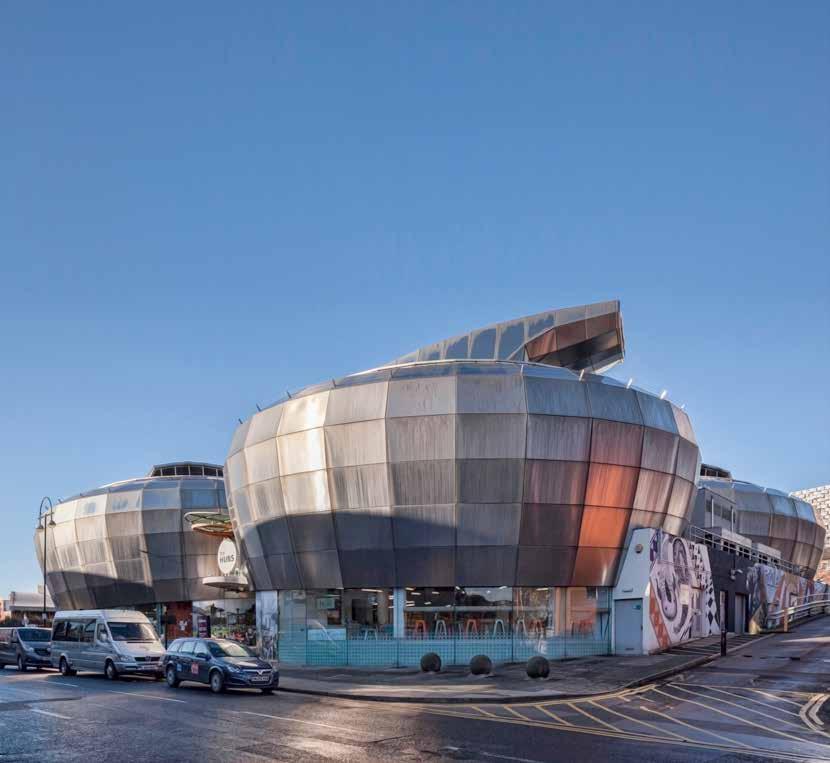
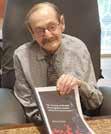

A very warm welcome to the latest edition of Mass Matters! In this issue we celebrate the return of in-person conferees by looking back at the amazing time we had at the 41st BMSS Annual Meeting in Sheffield Hallam, that took place September 8th-9th. It was so good to see all the familiar faces of the BMSS family and we hope the few perspectives we have in this issue remind you of the event.
This issue we also welcome Angela Taylor of Birmingham University, who joins the BMSS committee as a co-opted member. Welcome Ange!
Best, Jon.

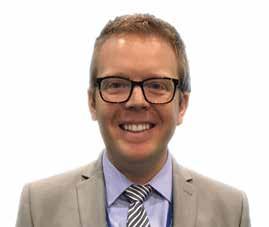

Chair’s Report
Dear BMSS members,
We’re back!!!
In early September the BMSS held its annual scientific meeting in Sheffield Hallam as a face-to-face event. It was truly wonderful to be back and to see so many old friends and make so many new acquaintances. This face-to-face event acted as a striking reminder of just how important it is to be able to get together. New friendships were formed through chance meetings that would simply not have happened in the virtual space. Random conversations have given legs to scientific discourse that, again, would not naturally fall out of virtual events. The feedback from this event was that of a huge success. Over 200 people made it to Sheffield and the atmosphere was full of life, laughter and excitement, and enthusiasm for the pursuance of wonderful mass spectrometry. We had two amazing plenary speakers, our very own Professor Tony Stace, BMSS Aston medal holder, opened the event and delivered a great Maccoll lecture exploring multiply charge ions. The second day got off to a great start thanks to Professor Jane Hurst OBE, who shared her amazing research into the application of mass spectrometry into animal behaviour…I will never look at mice in the same light again and have a whole new respect for them!
Never forgotten were those who were unable to make it to Sheffield in person. Lectures were recorded and all posters were digital so that everyone could enjoy sharing in the weeks beyond the face-to-face event. This hybrid form was new to us, and we appreciate that there were some digital teething troubles with the on-line content and apologies for any inconveniences caused. A huge thanks to those speakers who kindly re-recorded their presentations so we could make their contribution available –your extra effort is much appreciated by us all.
My personal sincere thanks to everyone who attended this great meeting, and to my BMSS colleagues to helped pull off such a successful event in such a short amount of time, and with a cloud of constant uncertainty hanging over them.
September, as well as celebrating the return of our scientific meeting, unfortunately also bought us the sad news of the passing of Professor Frank Pullen, BMSS medal holder and much loved by so many in our Society. Frank was always such a very positive and supportive character in our society and so we will celebrate the essence of Frank in a symposium next year. We are working to organise a suitably appropriate event in London for around April next year and will keep you all updated through the website.
Plans are also afoot for BMSS42, where we expect to return to the traditional format of the annual scientific meeting, albeit with some popular enhancements learned from the hybrid format from this year. We have just signed a contract with the Royal Northern College of Music in Manchester for 13-15th September 2022 and will be posting more information on the website very shortly so watch this space!
The BMSS Introduction to Mass Spectrometry Course is also returning. This year, we will host this as a live on-line event in December to enable new students to settle into their studies and join in with the teaching festivities. Again, registration information and additional details will be posted on-line very soon.
By way of continuing announcements, we will also be shortly opening calls for the 2022 summer studentship programme, so now would be a great time to think how BMSS (and our ChromSoc partners) can support your research.
And as 2021 begins to draw to an end, we start to build for an exciting
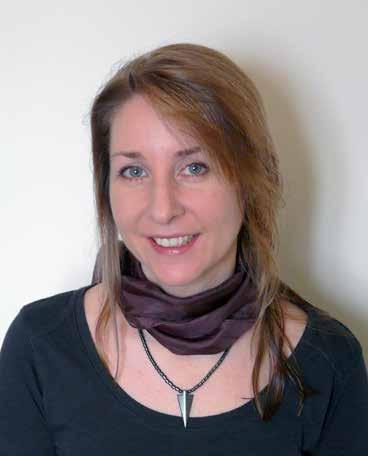
and promising 2022, please don’t forget to renew your membership: login into your account, click on My Locker, go to My Membership and click on the renew button, and join us for what promises to be some amazing events and opportunities at the end of this year and through 2022.
Dr Jackie Mosely
BMSS Chair
All the very best!
Jackie Mosely, BMSS Chair
2022 BMSS membership subscription
Renew your BMSS membership subscription for 2022!
You can renew quickly and easily on-line by visiting the BMSS Website: www.bmss.org.uk.
Why not also encourage colleagues to join the BMSS? As a member of the BMSS they will:
• Be part of a community of people with similar interests
• Have the opportunity to keep up to date with recent technological developments, learn more about MS and share knowledge and experience e.g. by joining Special Interest Groups (SIG’s)
• Be eligible to apply for grants towards small items of equipment, summer studentships and conference travel
• Be entitled to discounts for BMSS meetings
• Benefit from reduced subscription fees to the European Journal of Mass Spectrometry
• Receive copies of Mass Matters, the official benefit from 20% off relevant book titles when purchased via Wiley Publishing (discount code required) publication of the BMSS, published three times a year

Students: Can benefit from our education programme by applying for travel grants, presenting research at meetings and by taking part in the Barber oral prize and Bordoli poster prize competitions. All student members also receive a general mass spectrometry text book upon joining.
New & Established spectrometrists: Can benefit from courses, careers events, links with other societies (such as ChromSoc. & RSC) and networking via the BMSS Annual Conference and Special Interest Group Meetings.
Any membership queries should be directed to: Lisa Sage, BMSS Administrator T: (01606) 810562 E: admin@bmss.org.uk
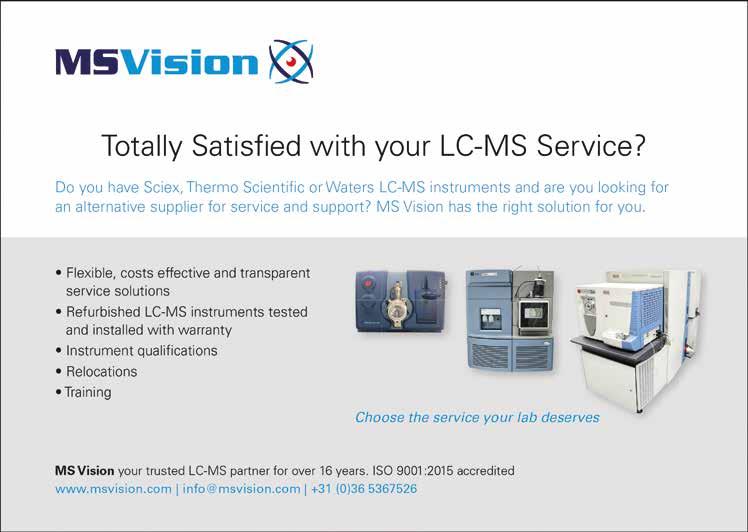

Recent publications by BMSS members...
Discovering protein–protein interaction stabilisers by native mass spectrometry.
Bellamy-Carter J., Mohata M., Falcicchio M., Basran J., Higuchi Y., Doveston R.G. & Leney A.C. Chem. Sci., 2021,12, 10724-10731 DOI: 10.1039/D1SC01450A
Molecular 'glues' that stick proteins together are hard to find. This is due to the lack of biophysical assays that can measure how good a glue is. Here, we show how native mass spectrometry can be used to measure molecular 'glues' and in doing so to screen for new 'glues' with therapeutic potential.
No evidence for increased loss of old carbon in a temperate organic soil after 13 years of simulated climatic warming despite increased CO2 emissions.
Briones MJI., Garnett MH., Ineson P., Global Change Biology, Vol 27 Iss 9, May 2021, p1836-1847 DOI: 10.1111/gcb.15540
We first investigated the long-term stability (13 years) oforganic C by combining in situ CO2 respiration measurements and radiocarbon (14C) analysis of soil C respired from the soil, leached as DOC and assimilated by key soil fauna. Second, we used natural abundance radiocarbon to partition ecosystem respiration into its autotrophic (plant root) and heterotrophic (microorganisms and soil animals) components to determine their contributions to ecosystem respiration in response to long-term warming
Selected ion flow tube mass spectrometry for targeted analysis of volatile organic compounds in human breath.
Belluomo I., Boshier PR., Myridakis A., Vadhwana B., Markar SR., Spanel P., Hanna GB. Nat Protoc. 2021 Jul;16(7):3419-3438. Epub 2021 Jun 4. PMID: 34089020 DOI: 10.1038/ s41596-021-00542-0.
Analysis of exhaled breath is emerging as a promising noninvasive diagnostic technique for different types of pathologies. Volatile organic compounds in breath are products of normal and aberrant metabolism, and they can be detected with mass spectrometry techniques. In this protocol, a comprehensive workflow for online and offline breath analysis using selected ion flow tube mass spectrometry is presented.
Influence of Biodiesel on Base Oil Oxidation as Measured by FTICR Mass Spectrometry.
Jones HE., Lozano DCP., Huener C., Thomas MJ., Aaserud DJ., J. DeMuth C., Robin MP., Barrow MP. Energy Fuels, 2021, 35, 15, pp. 11896–11908. DOI: 10.1021/acs. energyfuels.1c01240
Internal combustion engines require the use of lubricants but these are subject to thermo-oxidative degradation during use. It is also known that fuel can mix with the lubricants and the use of biodiesel can accelerate the oxidation process. Using FTICR mass spectrometry, we have investigated benchtop oxidation of a Group II base oil as a function of time and biofuel content.
OSIRIS-REx: a NASA Asteroid Space Mission.
March RE, International Journal of Mass Spectrometry 469 (2021) 116677. DOI: 10.1016/j. ijms.2021.116677
OSIRIS-REx is a NASA asteroid-study mission, launched September, 2016, with the goal of getting some 60 g of dust, soil and rock from Bennu. The OSIRIS-Rex spacecraft has achieved its objective and is due to parachute the sample over Omaha in 2023. This editorial is an alert to mass spectrometrists. Requests for milligrams of sample should be directed to Dr. Lauretta.
Hammett Correlation in the Accelerated Formation of 2,3-Diphenylquinoxalines in Nebuliser Microdroplets.
N W Fenwick., R Telford., A Saidykhan., W H C Martin and R D Bowen., Molecules, 2021, 26, 5077. doi: 10.3390/molecules26165077.
Novel competition experiments in which equimolar quantities of 1,2-phenylenediamine and a substituted 1,2-phenylenediamine compete to condense with benzil to form a 2,3-diphenylquinoxaline and a substituted 2,3-diphenylquinoxaline at an accelerated rate in nebulizer microdroplets have led to the development of a good Hammett correlation. This structure-reactivity relationship establishes that the phenylenediamine behaves as a nucleophile in this condensation.
This paper arose from the pioneering work done by Nathan Fenwick during the Summer of 2019 when he held a BMSS Summer Studentship at Bradford. Although the research
was completed during 2021 when Nathan was a PhD student, we have acknowledged that it was initiated during the tenure of the award, as indicated by the statement "This work was initiated during the tenure by N.W.F. of a 2019 BMSS Summer Studentship; this support from BMSS is gratefully acknowledged".
Negative-Ion Field Ionization and Liquid Injection Field Desorption/ Ionization-Mass Spectrometry on Recent Instrumentation.
Mathias H. Linden, H. Bernhard Linden, Jürgen H. Gross. Anal. Bioanal. Chem. 2021; Open Access, published online first at DOI:10.1007/s00216-021-03641-9
We explored negative-ion liquid injection field desorption/ionization (LIFDI) using modern mass spectrometers, i.e., a Waters Q-TOF and a JEOL AccuTOF instrument. LIFDI provides sampling under the exclusion of atmospheric oxygen and water, and thus, enables the analysis of highly sensitive compounds. We describe instrumental setups, identify operational parameters for robust operation, and discuss negative-ion LIFDI spectra of various compounds.
Metabolomic analysis reveals reliance on secondary plant metabolites to facilitate carnivory in the Cape sundew, Drosera capensis.
Hatcher CR., Sommer U., Heaney LM., Millett J. Ann Bot 2021;128(3):30114.
Metabolomic analysis of 72 plants in a time-series experiment before and after simulated prey capture was performed. For the first time in a carnivorous plant, the wholeleaf metabolome response to prey capture was investigated. Reliance on secondary plant metabolites was higher than previously thought, supporting the hypothesis that secondary metabolites play an important role in plant diversification and adaptation to new environments.
We’re back!
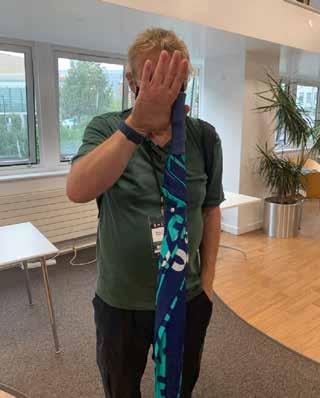
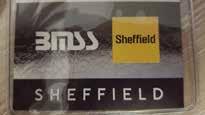

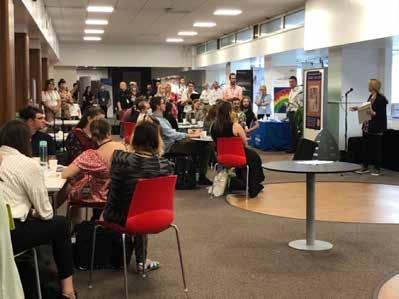
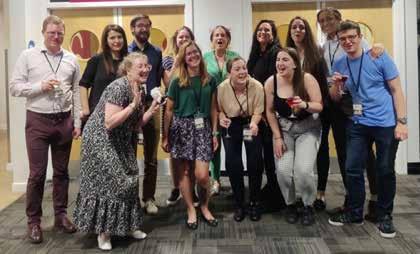
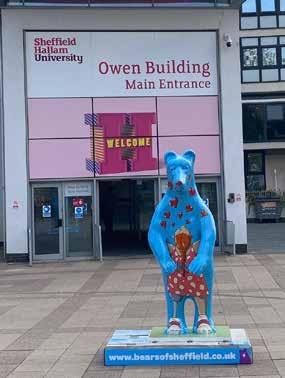
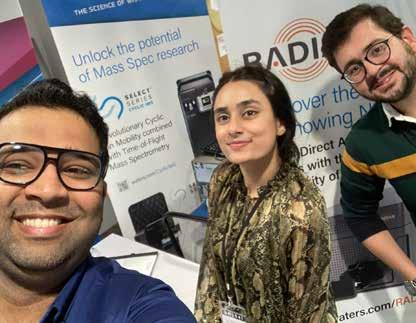
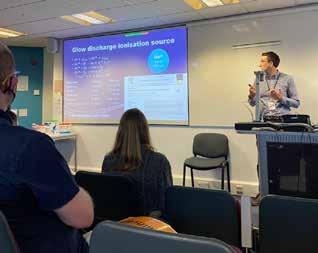
BMSS41 Reports
Anirudh Sharma
PhD Student, Teesside University
Anxious, confused and unsure that’s how I set off from my home for BMSS-2021 not knowing I would come back with lots of confidence, friends and a family. It was a very nice feeling to be able to see fellow mass spectrometrist and talk about science. Everything was well organised, and I managed to attend each session I wanted to because they were grouped very well.
Roy Goodacre
University of Liverpool
I have never been to a BMSS conference and so was very surprised to be invited by Andrea to give a talk on our work in mass spectrometry-based metabolomics. I guess part of the surprise came
The cocktail session was just the right place for networking, and I made lots of new connections. It was my first conference, and I was presenting my work to external audience for the first time during my PhD, so the nervousness levels were obviously high. But, when I entered the room, it didn’t seem me to an external audience, it was like we are a family with common goals.
By the time it was the end of the 2nd day, I was going home with lots
over 18 months, thanks to COVID.
I arrived in Sheffield the night before the meeting and wondered what lay ahead. It was to also be my first night in a hotel for a year and half. The hotel (a Mercure very close to the Peace Gardens) was great and I even managed a morning

of memories, experiences and above a family – a BMSS family. Don’t forget the freebies too!!
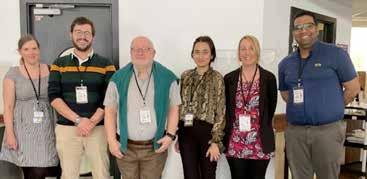
By the end of the first session, I realised that BMSS was actually a good home to be in and I felt comfortable. The thrill of being at a conference might have meant that I was wearing rose-tinted glasses, but the science on display was great. The work was diverse and ranged from developments in fundamental
urine that female mice found highly attractive. It was also nice that the organisers had poster flashes from the early career researchers as this allowed them to highlight the work within their electronics posters, as there would be no poster sessions with people crammed between boards.
conference. With a little trepidation I joined the throng at registration and after about 20 minutes or so it started to feel natural to be in the company of many scientists. I joked
had been reset! And that after 18 months of Zoom and Team online meetings that it was quite unusual to stand next to people and that

Over all the conference was very well planned, I felt COVID secure throughout the meeting and the organisers should be congratulated on putting on such a good meeting.
Will I be back? Yup I’m sure you’ll see more of me and our research group at BMSS future events!



How to herd cats: AKA Chairing a session at a scientific conference
Liam Heaney
Lecturer in Bioanalytical Science, Loughborough University
To both those who are widely experienced and those new to scientific research, there is a clear progression in learning and participation when considering the dissemination of knowledge. This begins by developing presentation skills that allow you to visualise and display your research, as well as the capacity to explain it clearly to a live audience. The usual steppingstones for this progression involve the presentation of a research poster, the delivery of an oral presentation, and finally the invitation to provide a keynote and/or plenary talk at a scientific event. These tasks are ubiquitous to both academia and industry alike and are an excellent way to sell your science, but also yourself.
Now let’s consider the scientific session in which you have been invited to present. These sessions are not just put together in a random order as they will usually fall under the umbrella of a certain topic(s) area and contain both invited (e.g. keynote) and submitted (via abstract) presentations. Whilst it is usually the job of the conference organisers to select the topic areas of interest, it is then the role of the Session Chair to invite and select colleagues to present. So, what is a Session Chair? This is an individual who has been invited by the conference organisers to provide the final organisation of a session in which the topic is close to their expertise, and who are then responsible for the smooth running
of the session during the conference itself. This overseeing role begins offsite by choosing a keynote speaker and the most appropriate submitted abstracts. This then shifts to the onsite responsibilities of introducing the speakers, facilitating questions from the audience (and asking their own question(s) if the audience does not volunteer itself!), and the general control of the session including running to the time schedule and ensuring the speaker and audience can be seen/ heard.
As a relatively early career scientist, I was asked to chair 2 of 6 sessions at BMSS41 where we had Flash Oral presentations. These consisted of a 5 min slide presentation, followed by up to 4 min of audience questions. This was the first time that this format of oral presentation has been used at a BMSS Annual Meeting, with the major contributing factor being the inability to predict whether an in-person poster session was going to
be possible due to potential social distancing related to COVID-19 transmission. This format of presentation is particularly well-suited to earlycareer scientists, or research projects that are still at the initial phase of investigation. This is mainly due to their short duration, allowing research students and junior employees to be provided with an initial opportunity to test their presentation skills without the potential pressure and nerves that are associated with a full 15-20 min oral slot. Equally, an individual working on a project that has
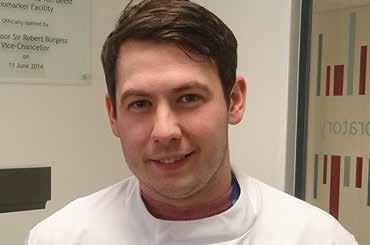
particularly interesting initial data, yet which is not at the stage to answer a hypothesis in full, can disseminate these findings to the audience with the opportunity for useful feedback from external parties.
Chairing the Flash Oral sessions was a particularly daunting prospect for me, most notably due to the fact that the included talks varied quite extensively in their topic and technical areas (albeit placed under a very wide umbrella term). To add to this, small runovers in time for the presentation and/or questions could have a knock-on effect for the following session, or also in this case for the hungry audience waiting for their buffet lunch! Nonetheless, it was time to face the music and my first task, ‘Flash Oral Session 2’, was about to start. The session began and all my original worries disappeared in a heartbeat. It was fantastic to see such confident delivery from participants ranging from recently graduated MChem students, right up to experienced members of industrial research. The talks were all clearly presented, graphically
appealing and kept (more or less) to the 5 min time limit. The majority of talks in my sessions were met with questions by the audience, with a small number requiring the input of myself as Chair to provide some level of inquisition. This was generally straight forward and I was able to ask questions related to the talk provided, with a couple of talks being quite far outside of my comfort zone and therefore really testing my questioning ability.
In all, I am incredibly proud of the efforts by the scientists presenting their work within the sessions I led, both for their capacity to effectively communicate their work, but also for the impeccable manner in which they answered questions which were often challenging in nature. I would fully encourage anybody who wishes to present their work to do so, it is a fantastic skill to develop. Additionally, for those who are invited to chair a scientific session, do accept the opportunity with enthusiasm and interest (I’m sure coupled with a bit of panic for good measure).



John Beynon Travel & Conference Fund

As we take tentative steps towards a return to ‘normal’, we thought to remind you of the opportunities to apply for assistance for travel costs. Its also a great way to have an article published in MassMatters when you submit your travel report!
This fund is dedicated to the memory of John Beynon, an eminent mass spectrometrist and one of the founders of our Society. In a career spanning four decades, John Beynon visited and collaborated with many notable scientists and was awarded the BMSS Aston Medal to recognise his contributions to the field of mass spectrometry.
Applications
• The BMSS welcome applications submitted up to four weeks prior to travel. Retrospective applications will not be accepted.
• If attending a conference, the applicant should normally be presenting.
• Applicants will be expected to seek an economical mode of transport.
• The maximum award that can be made is normally limited to £350. Applicants will be required to submit a report of their travel plus receipts and/or other proof of expense prior to the funds being released.
• Applications to attend BMSS meetings and evidence of funding
from other sources will be looked upon favourably.
• Applications will be dealt with on a first-come-first-served basis.
Eligibility
• Assistance is only available to BMSS members of three calendar months standing at the time the application is submitted.
• All members are eligible to apply, however preference will normally be given to students and other earlycareer researchers.
• Only one application per person per calendar year (1 January to 31 December) will be considered.
• The Committee reserves the right to limit the number of awards made to any one individual, organisation or department.
Terms and Conditions
• The successful applicant is required to acknowledge the BMSS on their presentations by including a copy of the BMSS logo (members can download here).
• The successful applicant must upload a travel report within one month of the meeting end. This is achieved through the link in the acceptance email.
• The BMSS Committee may elect to publish the travel report in the BMSS Newsletter or on the BMSS Web Pages or in other similar BMSS material.
• The travel report should be of good quality and concise. Two pages should be a maximum. For members attending a conference, a pdf of a poster, or two-page report on an oral presentation delivered in
the style of an extended abstract is acceptable.
• Expenses will be reimbursed by bacs transfer upon receipt of:
• The travel report.
• A completed expense claim form.
• Legible copies of appropriate receipts.
Members can apply via the BMSS website : www.bmss.org.uk/grants/johnbeynon-travel-and-conference-fund

All BMSS members are requested to respond to the 2021 EDI questionnaire anonymously at: www.tinyurl.com/bmss-edi




Haemoglobin Analysis by Brian N Green OBE
Brian N Green completed his latest book “The Analysis of Human Haemoglobin Variants using Mass Spectrometry”, during 2021. We asked Mike Morris, co-editor of the book for a perspective on this great achievement.
Mike Morris
Senior Director of MS Research Waters Corporation
When electrospray ionisation came to the fore in the late 1980s the focus was very much on the analysis of large molecules, particularly proteins. Brian Green was one of the key members of the VG team that helped implement the technology on the quadrupole systems, which resulted in the commercialisation of the VG BioQ in 1991. One of the challenges Brian faced was access to a widely available 'standard' protein sample that could be readily storedblood was the answer!
By the time the VG BioQ was launched, Brian had measured the masses of several normal and variant globin chains using a triple quadrupole instrument of modest mass range (m/z 2,000). An early indication of the potential of the technique in human haemoglobin analysis was the identification in 1991 of the clinically significant and electrophoretically silent variant, Hb Quebec-Chori, ß87Thr→Ile with Shackleton and Witkowska. ESI-MS played a major role in identifying this variant, which had not been previously reported in the literature.
In late 1996 Brian started to work with Barbara Wild, then at King’s College Hospital, London, on a programme of experiments to identify haemoglobinopathies that had been detected by traditional methods such as cation exchange-HPLC or isoelectric focusing. At this time, blood
samples were simply diluted 500-fold in denaturing solvent and introduced directly into the mass spectrometer. Consequently, sodium and potassium adducts of the globin chains were produced from the salts present, which interfered with measurement of the δ-chain and also sometimes with that of the variant-chain. They were eliminated by briefly shaking the 500-fold diluted blood solution with cation exchange resin beads before introduction into the mass spectrometer. By 2001, this desalting step had been incorporated into a routine procedure for analysing the intact globin chains in whole blood. A rapid (30-minute) method for routinely digesting the globin chains in diluted blood with trypsin was also developed, since tryptic digests are generally needed for identifying the site of the mutation. By 2001, 250 samples, which were suspected by traditional methods to contain an unidentified abnormality, had been analysed. Variants were positively identified in 95% of the samples. Hb S and common variants such as Hb C and Hb E were generally not submitted for analysis by mass spectrometry, provided they had been reliably identified by traditional means. Fifteen of these variants had not been previously reported in the literature, i.e. were novel when first encountered by the author of this book. This programme was discontinued in 2001. there was a strong interest from several UK hospitals for a service to be provided for identifying haemoglobinopathies, and over the period from 2001-2012, ~4,300 further samples were analysed by Brian in a programme supported by Waters Corporation. The abnormalities were identified in more than 98% of these cases. By December 2012, when this service was discontinued, 329 different variants had been identified, namely; 155α (46 novel), 166ß (31 novel),
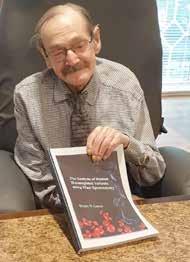
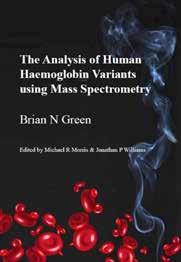
1δ, 2Gγ and 5 hybrids. 77* were novel when first encountered in Brian's experiments.
The book is a collation of Brian's studies on the analysis of human haemoglobin variants by mass spectrometry over the period from the introduction of Electrospray Ionisation in the late 1980s to his retirement in 2018. The work describes the five steps that he employed in determining the mutations in variant haemoglobins following the identification of a suspicious result from routine clinical investigations. Over the years he developed a number of tools and procedures that allowed for the unambiguous determination of amino acid mutations in the globin chains, and the underlying mass spectrometry experiments that underpin these conclusions.
The collection of data presented in Brian's book is a formalisation of the notes he prepared over his years of studying haemoglobin, and the annotation of the spectra he acquired and interpreted over that time. A plan to publish the work was initiated in 2012. Initially seen as a trivial job, finding the original data files from Brian's archive (some stored on media where readers were no longer available) made the task of completing the tome considerably
more onerous than envisaged. The re-creation of some 470 spectral figures from Brian's original files and hand-annotated documents took longer than anticipated, but finally drew to a close in mid-2021.
Although this work is focused on Brian's use of mass spectrometry on the analysis of haemoglobins, he made many contributions to the science of mass spectrometry from his first introduction to the technique in 1957 to his retirement from the laboratory in 2018. Many of his contributions were described in a previous issue of MassMatters after an interview with Jackie Moseley.
About Brian N Green
Born in Urmston, Manchester in 1933, Brian was recognised for his contributions to mass spectrometry by his appointment as an Officer of the Order of the British Empire in 1985, and the award of the BMSS Aston Medal in 1997.
Publication Note
“The Analysis of Human Haemoglobin Variants using Mass Spectrometry”, Green BN, Morris MR & Williams JP. In press 2021 via Waters Corporation.

The BMSS maintains an on-line directory of currently available career opportunities. The Society invites members to review the available options, and solicits new postings from prospective employers at: https://www.bmss.org.uk/jobs/

Joint UK-Australian PhD Position in Investigation of new and emerging pollutants and microplastics sources in atmosphere and their toxicological effects
Organisation: Coventry and Deakin Universities
Salary: £15,000 bursary plus tuition fees - UK/EU/International + return ticket to Australia
Duration: 3.5 years
There is a strong concern over growing number of allergies and premature deaths from poor air quality. Particulates are the most harmful form of air pollution due to their ability to penetrate deep into the lungs, blood streams and brain. These particulates are loaded with 1000s of organic chemicals, however, only a small fraction of particulates’ organic carbon is identified at molecular level (<20%). So-called new and emerging pollutants (NEPs) e.g. pharmaceuticals, pesticides, industrial chemicals, personal care products and microplastics have been relatively recently identified in aquatic and soil environments.
Although NEPs is a term used for soil and aquatic environments, most of them have chemical properties enabling their easy transfer into atmosphere. The project will investigate, NEPs (including microplastics) in atmospheric particulates. This will be done through analytical method development for measuring NEPs, field campaigns (near NEPs emission sources and at a background urban site), lab experiments to understand NEPs transfer mechanism from their sources and assessment of cytotoxicity and the inflammatory response in human bronchial epithelial cells cultured in vitro at air-liquid interface.
The project will utilise state-ofthe arts analytical instruments including Orbitrap High-Resolution Mass Spectrometry coupled to Thermal Desorption and Pyrolysis Gas Chromatography, and Infrared Microscopy.
Mass Spectrometry Technician (Metabolomics)
Organisation:
University of Strathclyde
Salary: £28,756 - £32,344
Duration: Open Contract
You will manage the operational aspects of the new mass spectrometry metabolomics centre based in the Strathclyde Institute of Pharmacy and Biomedical Sciences. Primary responsibilities will revolve around metabolomics method development on newly installed Thermo Exploris 240 UHPLC-MS and a Shimadzu 8060 QQQ systems. You will also be proactive in setting up and running new experimental protocols for the analysis of biological samples (cell culture/tissue/biofluid). A comprehensive technical knowledge of mass spectrometry (triple quadrupole and high resolution) is an essential requirement. You will ensure maximum uptime of the mass spectrometry equipment, by ensuring routine maintenance, maintenance of part stock levels and troubleshooting through direct consultation with the equipment vendors and project partners. You will work closely with internal and external academic staff alongside NHS clinicians and will provide support on a wide range of clinical projects.
Application Specialist, Sales Support
Proteomics, EMEA
Organisation:
Thermo Fisher Scientific Duration: Permanent
Reporting to the Manager Sales Support Omics, EMEA, you will support the sales process, market growth and early adoption of LSMS products and workflows in Proteomics across EMEA. You will need strong hands-on and practical knowledge to provide technical presales and post-sales support. You will work in close collaboration with the sales, service, marketing and R&D teams.
Include customer calls/visits together with sales colleagues, technical advice and support of sales colleagues, customer support and training, on-site method implementation, occasional product demonstrations and support of scientific events within EMEA. The role is home-based within the United Kingdom.
PhD Studentship in Lipidomic and Antibiotic Resistance
Characterisation of Activated Sludge
Wastewater Reactors
Organisation: Sheffield Hallam University
Salary: £15,609 + full Home tuition
Duration: 3.5 years
Microorganisms play a key role in degrading environmentally hazardous industrial and municipal wastewater, preventing damage to ecosystems. Escalating population growth and rigidified environmental regulations place increasing demands on the wastewater industry. This project focuses on characterising the system disturbances caused by foaming events in wastewater reactors, which decrease the efficiency of wastewater degradation. This information will allow plant operators to better understand the causes of foaming events, the associated risks, and to develop predictive tools. In addition to playing a role in initiation of foaming events, shifts in wastewater microbial community composition have also been linked to the selection and enrichment of antibiotic resistant bacterial populations, including many human pathogens.
This doctoral program aims to characterise the emergence of antibiotic resistance in both in situ and replica in vitro wastewater systems in response to foaming, and to correlate these to lipidomic changes. The successful applicant will gain a range of interdisciplinary
skills, including state-of-theart analytical techniques such as ultraperformance liquid chromatograph-high resolution mass spectrometry, target analysis and big data processing of lipidomic data, bioinformatics molecular microbiology and biofilm-modelling

In Memoriam: Friends we have lost in 2021
Frank Pullen
Bill Kelly
Remembrance words courtesy of Eddie Clayton
Bill Kelly was a visiting member of Rowland Reed’s group at Glasgow back in 1961 -1963, he had been seconded from Unilever to learn the fundamentals of organic mass spectrometry prior to setting up the laboratory at Sharnbrook. In this he was disappointed in some respects as RIR had little time for mechanisms in fragmentation (surprising for someone who had studied under Ingold). Bill was responsible for improving the use of the direct insertion probe, which Reed had pioneered, by introducing a pumped housing which saved having to ventilate and then pump down the whole spectrometer for each sample, no short time in the days of heated oil diffusion pumps. It was a considerable disappointment to us when our first MS9 arrived without a pumped housing and a solid probe that had to be screwed on to a gold seal while the source was vented, we were almost back to square one.
Bill was also a leading proponent of the use of GC-MS in this country using a simple capillary sampler, this before the days of separators, or capillary columns and massive pumps that could take the whole of the output of a capillary GC. To the delight of the AEI users group he played recordings from an audio tape of the spectra of toluene and benzene from a GC-MS run and you could tell the difference by the sound they made. The audio tapes could then be processed offline into spectra. Bill was always a gentleman and good company and he was a sound mentor to Hilson Hill and myself in the first year of our doctoral studies.

It is with the greatest sadness that I announced the passing of Professor Frank Pullen on 2nd September 2021.
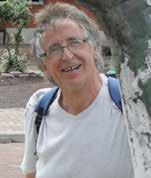
Frank, a much loved mass spectrometrist, has taught and inspired so many of us through his time in industry and academia.
Frank has always been a big part of the BMSS community. He regularly attending meetings, presenting his research countless times and judging the Barber and Bordoli prizes. Frank also helped shape our Society while serving as committee member, Vice Chair and Chair of our Society before supporting us as a member of the BMSS Advisory Board. In 2010 Frank went On Tour on behalf of the BMSS as the BMSS lecturer, visiting 14 different venues to share his knowledge and spread his enthusiasm for mass spectrometry.
Such is his contribution to UK mass spectrometry, Frank was awarded the BMSS Medal in 2014.
Reflections: Mass Spectrometry and Me
Emily Kempa, PhD
Interviewed by Mervyn Lewis, Associate Editor.
What was your impression of mass spectrometry when you were first introduced to it?
I was first introduced to mass spectrometry (EI spectra) at A-Level, and along with information from other analytical techniques, I enjoyed the challenge of identifying unknown compounds from their spectra. The problem-solving aspect was almost like a puzzle and sparked a general interest in analytical science.
What persuaded you that mass spectrometry could be a good career option for you? Were you attracted by an application of mass spectrometry or excited by the prospect of developing it as an instrumental technique?
Initially, it was the applications and versatile nature of the technique that attracted me to mass spectrometry, and upon undertaking a placement year in the GC-MS method development team at Intertek (Blackley, Manchester) I gained several key skills in this area, particularly in sample preparation, instrument operation and the analysis of data, both qualitative and quantitative. Although I enjoyed application development, it did open my eyes to instrument maintenance and construction, and in particular, I found I enjoyed taking instruments apart, learning about their components and putting them back together again! It wasn’t until I joined the Perdita Barran research group in 2015 that I began to consider the possibility of developing new or improving
existing instruments and this, along with high throughput screening, has become my main research focus.
How did you go about finding your first opportunity in mass spectrometry?
When applying for an industrial placement year, I specifically targeted analytical scientist roles and was fortunate to find the Intertek student placement role advertised through my universities career service. When placing me within a team they asked if I had a preference to which analytical technique I wanted to learn first. Upon joining the GC-MS method development team I found the work both satisfying and enjoyable and this resulted in me remaining in the team for the entirety of my 15-month placement.
In what application fields do you see new opportunities in mass spectrometry?
The label-free detection capabilities of mass spectrometry, along with the many inlet technologies available do make for an incredibly versatile technique, and I believe many applications within biotechnology and healthcare will bring about new opportunities in the future. I feel the emergence of COVID-19 and the pandemic, has shone a light on the possibility to exploit mass spectrometry in more healthcare applications, with screening for diseases in a high throughput manner likely to become increasingly important. The discovery of new novel antibiotics to tackle multi-resistant bacterial strains is also a notable existing application, with many already researching in this area. The design and large scale production of
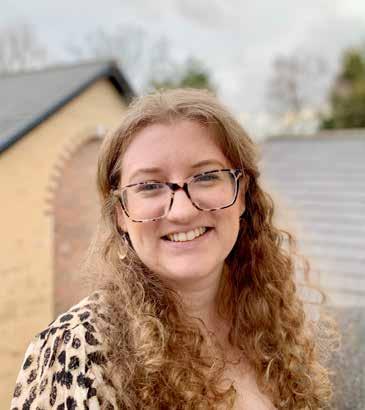
biofuels amid the global warming and energy crises is also likely to be seen as a worthwhile investment within the sector, as an increasing reliance upon sustainable resources becomes apparent.
All of the above applications are heavily reliant on robust and accelerated screening technologies of which there are several mass spectrometry platforms available on the market. However, as sample numbers, disease variants or possible reaction conditions increase so does the requirement to increase the speed of the technology further. This exemplifies the need to continually develop new inlet technologies capable of these ever-increasing speeds, and in particular, I see microfluidic coupled technologies and acoustic mist ionization as the current forerunners for this. With increased sample throughput also comes
increasing amounts of data analysis, something that upcoming software (and analysts!) should be prepared for.
What is your opinion about the impact that automation and informatics will have on mass spectrometry?
Automation is already somewhat critical to mass spectrometry platforms, with many analysts reliant upon auto-samplers to infuse samples into their instrument of choice. I believe this will become even more apparent as sample numbers increase, with plate/slide changers becoming commonplace to increase the number of samples available for analysis before userplate intervention is required. Furthermore, the implementation of robotics into the workflow before mass spectrometry infusion will
also be crucial to reduce bottlenecks during sample preparation steps and remove reliance on hand pipetting. Many laboratories performing high throughput screening are already transitioning from 96 to 384-well plate format, a natural next step to increase sample throughput with the additional benefit of miniaturized sample volumes.
As mentioned previously, with increasing sample numbers, comes ever-increasing amounts of data. Information scientists will be crucial to making sense of, and extracting useful features from such large data sets. Without the capacity to do this, and perform statistical analysis on the data, high throughput workflows are likely to stall at their final stages.
Could you describe your views on career prospects in mass spectrometry for young people?
I feel the prospects for young people entering into the field in the UK are largely good. I would say all experience within the field is good experience, and partaking in training in complementary techniques such as chromatography is beneficial to finding a mass spectrometry job, particularly for application scientists. The versatility of MS as an analytical technique allows for broad applications, and thus (hopefully!) jobs!
Looking back, gaining an increased understanding and experience in coding and the computational sciences, particularly software development, would have been beneficial, as writing bespoke packages for data analysis has become a highly sought-after skill. To those embarking on careers in mass spectrometry, I would certainly advise to undertake some coding, and also statistical analysis courses if they have not already.
throughout her PhD, the University of Manchester for access to their research facilities, and the BBSRC and Sphere Fluidics Ltd for their generous funding. Emily is now employed by AstraZeneca within the Early Chemical Development function in Macclesfield. Please note that AstraZeneca is not affiliated with this article.
B M S S S u m m e r S t u d e n t s h i p s 2 0 2 2
★ Summer Studentships provide funding for a research project typically lasting 6-8 weeks.
« Up to £2000 per Research Project.
« Complimentary 5-Year BMSS membership offered to each selected student.
« Complimentary registration for one BMSS Introduction to Mass Spectrometry Training Course offered to each selected student.
« Complimentary registration for one BMSS Annual Meeting offered to each selected student.
« Travel assistance offered to each selected student to facilitate their attendance at one BMSS Annual Meeting/Training Course.
« Students accepting complimentary registration for an Annual Meeting are expected to make a scientific contribution to that meeting.
« Applications must be made by research project supervisors.
« Research project applications may be submitted before a student is identified.
« The call for applications will open on Friday 12th November 2021 and close on Friday 14th January 2022.
« ENQUIRIES: The BMSS Education Officer M.P.Barrow@warwick.ac.uk

Acknowledgement
Emily would like to thank Prof. Perdita Barran for her support




School
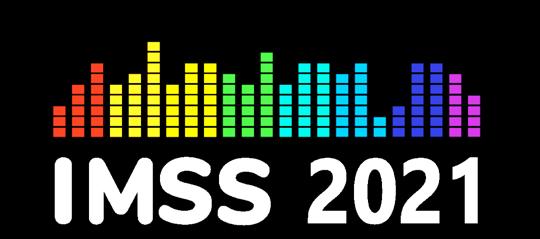
I M S S 2 0 2 2


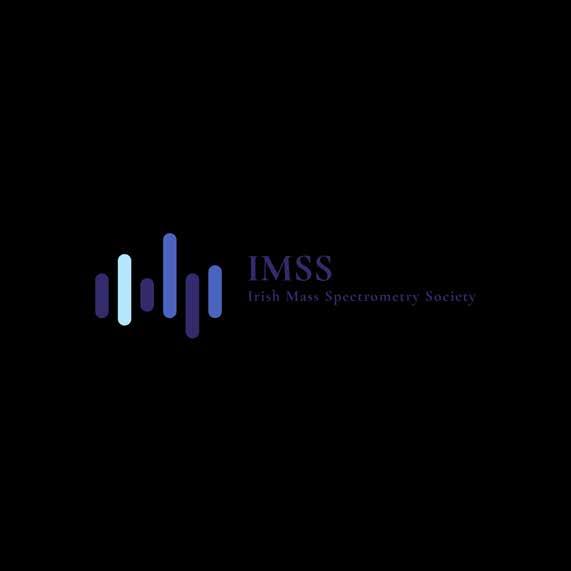
The International Mass Spectrometry Foundation (IMSF) and the Irish Mass Spectrometry Society (IMSS) with the support of the British Mass Spectrometry Society (BMSS) & Ulster University invite you to IMSS 2022
